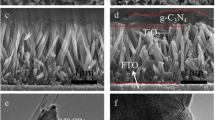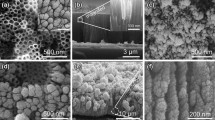Abstract
Photoanodes in quantum-dot-sensitized solar cells are essential to the process of light collection and charge transfer. In this paper, three-dimensional inverse opal (ZnO@ZIF-8 3D IO) photoanode is fabricated via a self-assembled opal template method. The synthesized photoanode has completely connected pores with extended diameter, thus promoting the permeability of QDs and electrolyte. Meanwhile, the light trapping ability and charge transfer process can be enhanced due to the slow photon and multi-scattering effect of the regularly interconnected macroporous array structure. ZIF-8 shell coated on the surface of ZnO IO not only provides high porosity but also serves as a protective passivation layer to reduce the carriers recombination occurred at the interfacial. In order to investigate the charge transport mechanism of ZnO @ ZIF-8 IO, cascaded CdS/CdSe quantum dots were used as sensitizers. Benefiting from the IO structure and ZIF-8 modification, the photoelectric conversion efficiency of solar cells based on ZnO@ZIF-8 IO can reach 1.75% (1.71 ± 0.04%), almost twice of that of the solar cells based on ZnO IO photoanode (0.81 ± 0.05%).











Similar content being viewed by others
References
Boro B, Gogoi B, Rajbongshi B, Ramchiary A (2018) Nano-structured TiO2/ZnO nanocomposite for dye-sensitized solar cells application: a review. Renew Sustain Energy Rev 81:2264–2270
Ge J, Li W, He X, Chen H, Fang W, Du X, Li Y, Zhao L (2020) Hybrid CdSe/CsPbI3 quantum dots for interface engineering in perovskite solar cells. Sustain Energy Fuels. https://doi.org/10.1039/C9SE01205B
Singh N, Salam Z, Subasri A, Sivasankar N, Subramania A (2018) Development of porous TiO2 nanofibers by solvosonication process for high performance quantum dot sensitized solar cell. Solar Energy Mater Solar Cells 179:417–426
Jiao S, Du J, Du Z, Long D, Jiang W, Pan Z, Li Y, Zhong X (2017) Nitrogen-doped mesoporous carbons as counter electrodes in quantum dot sensitized solar cells with a conversion efficiency exceeding 12. J Phys Chem Lett 8:559–564
Muthalif MPA, Sunesh CD, Choe Y (2018) Improved photovoltaic performance of quantum dot-sensitized solar cells based on highly electrocatalytic Ca-doped CuS counter electrodes. J Photochem Photobiol Chem 358:177–185
Wang W, Feng W, Du J, Xue W, Zhang L, Zhao L, Li Y, Zhong X (2018) Cosensitized quantum dot solar cells with conversion efficiency over 12. Adv Mater 30:1705746. https://doi.org/10.1002/adma.201705746
Margraf JT, Ruland A, Sgobba V, Guldi DM, Clark T (2013) Quantum-dot-sensitized solar cells: understanding linker molecules through theory and experiment. Langmuir 29:2434–2438
Wang X, Ran L, Dong L, Dong Y, Wang C, Xiong Y (2016) Enhanced full-spectrum water splitting by confining plasmonic Au nanoparticles in N-doped TiO2 bowl nanoarrays. Nano Energy 24:87–93
Wang W, Dong J, Ye X, Li Y, Ma Y, Qi L (2016) Heterostructured TiO2 Nanorod@Nanobowl arrays for efficient photoelectrochemical water splitting. Small 12:1469–1478
Mehmood U, Harrabi K, Hussein IA, Ahmed S (2017) Enhanced photovoltaic performance of dye-sensitized solar cells using TiO2-graphene microplatelets hybrid photoanode. IEEE J Photovolt 6:196–201
Li Y, Li W, Zhao L, Ge J, He X, Fang W, Chen H (2019) Constructing micro-flower modified porous TiO2 photoanode for efficient quantum dots sensitized solar cells. J Photochem Photobiol Chem 375:77–84
Zhou S, Tang R, Li H, Fu L, Li B, Yin L (2019) Fluorescence resonance energy transfer effect enhanced high performance of Si quantum dots/CsPbBr3 inverse opal heterostructure perovskite solar cells. J Power Sources 439:227065. https://doi.org/10.1016/j.jpowsour.2019.227065
Luo D, Chen Q, Qiu Y, Liu B, Zhang M (2019) Carbon dots-decorated Bi2WO6 in an inverse opal film as a photoanode for photoelectrochemical solar energy conversion under visible-light irradiation. Materials 12:1713. https://doi.org/10.3390/ma12101713
Zhu Y, Tong X, Song H, Wang Y, Qiao Z, Qiu D, Huang J, Lu Z (2018) CsPbBr 3 perovskite quantum dots/ZnO inverse opal electrodes: photoelectrochemical sensing for dihydronicotinamide adenine dinucleotide under visible irradiation. Dalton Trans 47:10057–10062
Hori K, Zhang Y, Tusamalee P, Nakazawa N, Yoshihara Y, Wang R, Toyoda T, Hayase S, Shen Q (2018) Interface passivation effects on the photovoltaic performance of quantum dot sensitized inverse opal TiO2 solar cells. Nanomaterials 8:460. https://doi.org/10.3390/nano8070460
Eftekhari E, Broisson P, Nikhil A, Wu Z, Cole IS, Li X, Zhao D, Li Q (2017) Sandwich-structured TiO2 inverse opal circulates slow photons for tremendous improvement in solar energy conversion efficiency. J Mater Chem A 5:12803–12810
Liu J, Yao M, Shen L (2019) Third generation photovoltaic cells based on photonic crystals. J Mater Chem C 7:3121–3145
Oh Y, Yang W, Tan J, Lee H, Park J, Moon J (2019) Boosting visible light harvesting in p-type ternary oxides for solar-to-hydrogen conversion using inverse opal structure. Adv Funct Mater 29:1900194. https://doi.org/10.1002/adfm.201900194
Zhang H, Zhou W, Yang Y, Cheng C (2017) 3D WO3/BiVO4/cobalt phosphate composites inverse opal photoanode for efficient photoelectrochemical water splitting. Small 13:1603840. https://doi.org/10.1002/smll.201603840
Lin X, Aumaitre C, Kervella Y, Lapertot G, Rodríguez-Seco C, Palomares E, Demadrille R, Reiss P (2018) Increasing the efficiency of organic dye-sensitized solar cells over 10.3% using locally ordered inverse opal nanostructures in the photoelectrode. Adv Funct Mater 28:1706291. https://doi.org/10.1002/adfm.201706291
Wang Z, Li X, Ling H, Tan CK, Yeo LP, Grimsdale AC, Aiy T (2018) 3D FTO/FTO-Nanocrystal/TiO2 composite inverse opal photoanode for efficient photoelectrochemical water splitting. Small 14:1800395. https://doi.org/10.1002/smll.201800395
Qi L, Low ZX, Yi F, Leong S, Zhong Z, Yao J, Hapgood K, Wang H (2014) Direct conversion of two-dimensional ZIF-L film to porous ZnO nano-sheet film and its performance as photoanode in dye-sensitized solar cell. Microporous Mesoporous Mater 194:1–7
Kilic B, Turkdogan S (2017) Fabrication of dye-sensitized solar cells using graphene sandwiched 3D-ZnO nanostructures based photoanode and Pt-free pyrite counter electrode. Mater Lett 193:195–198
Raj CJ, Karthick SN, Park S, Hemalatha KV, Kim SK, Prabakar K, Kim HJ (2014) Improved photovoltaic performance of CdSe/CdS/PbS quantum dot sensitized ZnO nanorod array solar cell. J Power Sources 248:439–446
Li S, Zhang P, Chen H, Wang Y, Liu D, Wu J, Sarvari H, Chen ZD (2017) Mesoporous PbI2 assisted growth of large perovskite grains for efficient perovskite solar cells based on ZnO nanorods. J Power Sources 342:990–997
Feng HL, Wu WQ, Rao HS, Li LB, Kuang DB, Su CY (2015) Three-dimensional hyperbranched TiO2/ZnO heterostructured arrays for efficient quantum dot-sensitized solar cells. J Mater Chem A 3:14826–14832
Li Y, Pang A, Wang C, Wei M (2011) Metal-organic frameworks: promising materials for improving the open circuit voltage of dye-sensitized solar cells. J Mater Chem 21:17259–17264
Chung HY, Lin CH, Prabu S, Wang HW (2018) Perovskite solar cells using TiO2 layers coated with metal-organic framework material ZIF-8. J Chin Chem Soc 65:1476–1481
Gu A, Xiang W, Wang T, Gu S, Zhao X (2017) Enhance photovoltaic performance of tris(2,2′-bipyridine) cobalt(II)/(III) based dye-sensitized solar cells via modifying TiO2 surface with metal-organic frameworks. Sol Energy 147:126–132
Zhang M, Shang Q, Wan Y, Cheng Q, Liao G, Pan Z (2019) Self-template synthesis of double-shell TiO2@ZIF-8 hollow nanospheres via sonocrystallization with enhanced photocatalytic activities in hydrogen generation. Appl Catal B Environ 241:149–158
Tian P, Shen K, Chen J, Fan T, Fang R, Li Y (2018) Self-templated formation of Pt@ ZIF-8/SiO2 composite with 3D-ordered macropores and size-selective catalytic properties. Small Methods 2:1800219. https://doi.org/10.1002/smtd.201800219
Li Y, Chen C, Sun X, Dou J, Wei M (2015) Metal-organic frameworks at interfaces in dye-sensitized solar cells. Chemsuschem 7:2469–2472
Shen K, Zhang L, Chen X, Liu L, Zhang D, Han Y, Chen J, Long J, Luque R, Li Y (2018) Ordered macro-microporous metal-organic framework single crystals. Science 359:206–210
Karuturi SK, Liu L, Su LT, Chutinan A, Kherani NP, Chan TK, Osipowicz T, Yoong Tok AI (2011) Gradient inverse opal photonic crystals via spatially controlled template replication of self-assembled opals. Nanoscale 3:4951–4954
Tsai CW, Langner EHG (2016) The effect of synthesis temperature on the particle size of nano-ZIF-8. Microporous Mesoporous Mater 221:8–13
Ge J, Li W, Zhao L, Li Y, He X, Fang W, Chen H, Zhang F (2019) Constructing cellular network TiO2 photoanode for simultaneous regulation of charge transport and light harvesting properties of quantum dots sensitized solar cells. Ceram Int 45:3715–3722
Wang G, Wei H, Shi J, Xu Y, Wu H, Luo Y, Li D, Meng Q (2017) Significantly enhanced energy conversion efficiency of CuInS2 quantum dot sensitized solar cells by controlling surface defects. Nano Energy 35:17–25
Zhou S, Tang R, Yin L (2017) Slow-photon-effect-induced photoelectrical-conversion efficiency enhancement for carbon-quantum-dot-sensitized inorganic CsPbBr3 inverse opal perovskite solar cells. Adv Mater 29:1703682. https://doi.org/10.1002/adma.201703682
Lee L (2007) Flat-band potential of a semiconductor: using the Mott–Schottky equation. J Chem Educ 84:685–688
Hwang I, Yong K (2015) Counter electrodes for quantum-dot-sensitized solar cells. Chemelectrochem 2:634–653
Wu M, Lin X, Wang Y, Ma T (2015) Counter electrode materials combined with redox couples in dye- and quantum dot-sensitized solar cells. J Mater Chem A 3:19638–19656
Du J, Du Z, Hu JS, Pan Z, Shen Q, Sun J, Long D, Dong H, Sun L, Zhong X (2016) Zn–Cu–In–Se quantum dot solar cells with a certified power conversion efficiency of 116%. J Am Chem Soc 138:4201–4209
Acknowledgements
This work was financially supported by the National Natural Science Foundation of China (61604110, 51802234), Hong Kong Scholars Program (XJ2019025), Natural Science Foundation of Hubei Provincial (2018CFC796), China Scholarship Council (201808420125).
Author information
Authors and Affiliations
Corresponding authors
Ethics declarations
Conflict of interest
There are no conflicts to declare.
Additional information
Publisher's Note
Springer Nature remains neutral with regard to jurisdictional claims in published maps and institutional affiliations.
Rights and permissions
About this article
Cite this article
Li, Y., Xiao, S., Li, W. et al. ZnO@ZIF-8 inverse opal structure photoanode for efficient CdS/CdSe co-sensitized quantum dot solar cells. J Mater Sci 55, 7453–7463 (2020). https://doi.org/10.1007/s10853-020-04534-5
Received:
Accepted:
Published:
Issue Date:
DOI: https://doi.org/10.1007/s10853-020-04534-5




